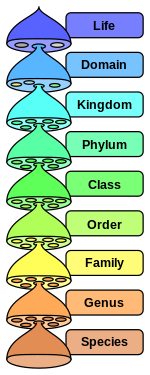Top Qs
Timeline
Chat
Perspective
Subphylum
Taxonomic rank From Wikipedia, the free encyclopedia
Remove ads
In zoological nomenclature, a subphylum is a taxonomic rank below the rank of phylum.
This article needs additional citations for verification. (January 2021) |

The taxonomic rank of "subdivision" in fungi and plant taxonomy is equivalent to "subphylum" in zoological taxonomy. Some plant taxonomists have also used the rank of subphylum, for instance monocotyledons as a subphylum of phylum Angiospermae and vertebrates as a subphylum of phylum Chordata.[1]
Remove ads
Taxonomic rank
Subphylum is:
- subordinate to the phylum
- superordinate to the infraphylum, which is in turn superordinate to parvphylum.[2]
Where convenient, subphyla in turn can be divided into infraphyla; in turn such an infraphylum also would be superordinate to any classes or superclasses in the hierarchy.
Examples
Not all fauna phyla are divided into subphyla. Those that are include:
- Arthropoda: divided into subphyla Trilobitomorpha, Chelicerata, Myriapoda, and Pancrustacea
- Brachiopoda: divided into subphyla Linguliformea, Craniformea and Rhynchonelliformea
- Chordata: divided into Tunicata, Cephalochordata, and its largest subphylum Vertebrata
Examples of infraphyla include the Mycetozoa, the Gnathostomata and the Agnatha.
Remove ads
References
Bibliography
Wikiwand - on
Seamless Wikipedia browsing. On steroids.
Remove ads
